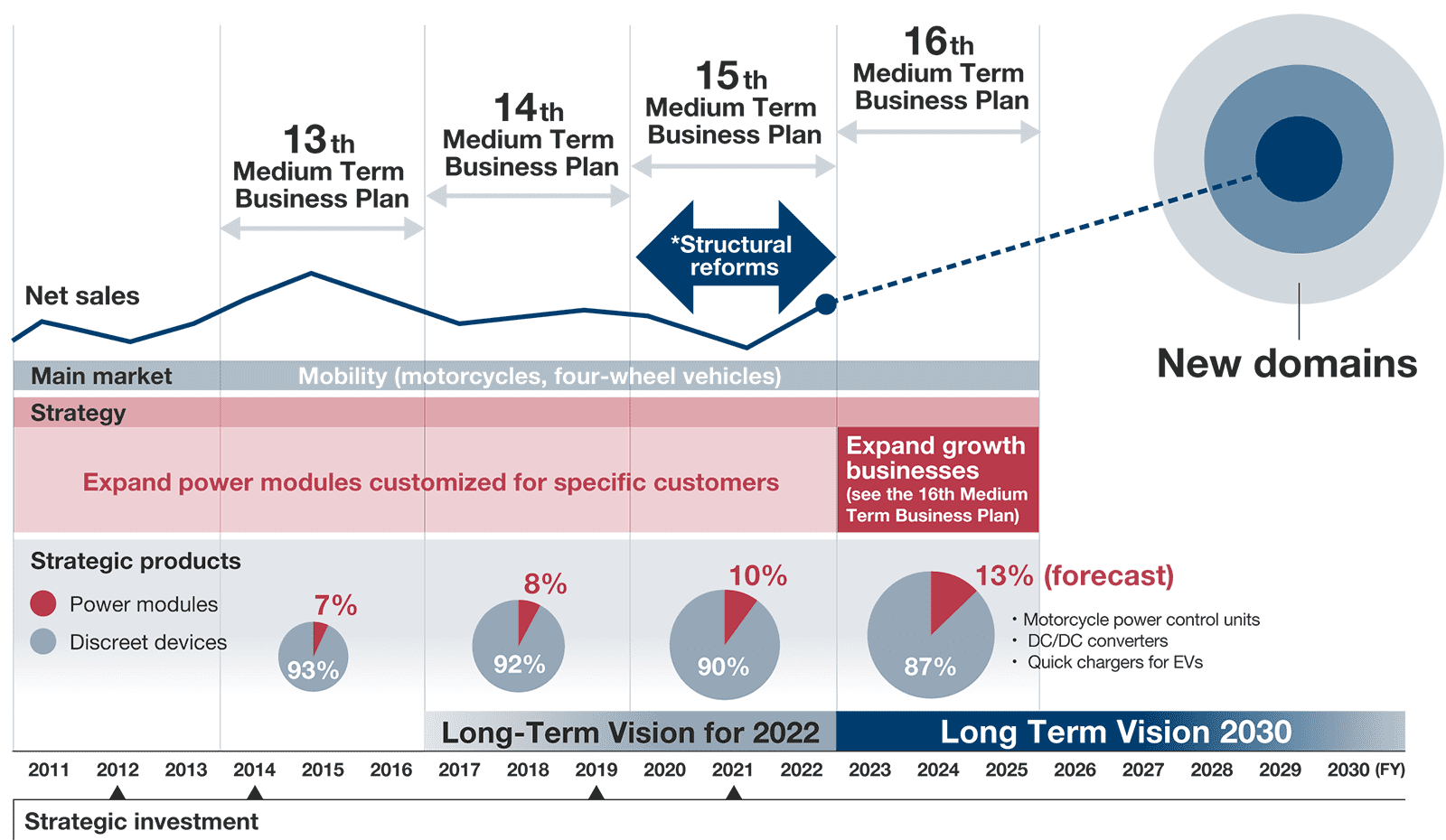Who We Are
The Evolution of Our Business Model and Efforts to Realize a Sustainable Society
Since 2010, the Shindengen Group has been working to transform its business model with the goal of using power semiconductors as key parts to advance product development that generates synergies.
Beginning in 2022, under the newly established Long-Term Vision 2030, we are working to further reinforce the business model and build a product portfolio that meets evolving needs. By doing so, we aim to increase corporate value and contribute to the realization of a sustainable society.

2012 Established Shindengen India Private Limited as a subsidiary in Karnataka, India
2014 Established Shindengen Lao Co., Ltd. as a subsidiary in Champasak Province, Laos
2019 Acquired all shares of Hermes Systems Inc., making it a subsidiary
2021 Opened the Asaka Office in Saitama, Japan
*Business Structure Reforms
The Shindengen Group has been implementing business structure reforms since November 2020. These reforms are aimed at building a revenue structure that is resilient to changes in the market environment and reinforcing competitiveness primarily in mobility and industrial machinery, which we have designated as key markets, in order to increase corporate value.
Business Structure Reform Measures
(1) Reorganizing the development framework
- We have transferred the development functions of the Hanno Factory to the Asaka Office, opened in April 2021, as well as to domestic Group companies.
- We have consolidated R&D, business operation and management functions at the Asaka Office.
- We decommissioned the clean room at the Hanno factory in March 2021, bringing an end to the R&D and business operation functions of the Hanno Factory.
(2) Revising production systems
Electronic Device:
- Some power module production lines of Akita Shindengen have been replaced by high-productivity lines that incorporate IoT at Lumphun Shindengen (Thailand).
- Akita Shindengen is building production lines for next-generation power modules.
- Higashine Shindengen has closed one of its clean rooms, improving the utilization of front-end processing facilities by approximately 20%.
- The closure of two clean rooms has reduced the number of clean rooms in Japan from five to three.
- A shift to larger semiconductor wafer sizes at Akita Shindengen and Higashine Shindengen have been improving front-end processing productivity by approximately 30%.
Car Electronics:
- We have moved production of some products from Japan to overseas factories.
- We revised the allocation of our production in Thailand, Vietnam, Indonesia, India and China, promoting optimization in each product category.
- In Japan we advanced automation and labor-saving measures, mainly for four-wheel vehicle products, such as DC/DC converters.
(3) Rationalizing unprofitable products
- We ceased production of power conditioners for photovoltaic generation.
- In semiconductors and other businesses, we are speeding up revisions of our product portfolio to rationalize low-profit products and improve overall profitability.
(4) Adjusting staffing levels
In fiscal 2020, we solicited voluntary retirement and took other measures that resulted in an 11% reduction in personnel at the domestic Group. By doing so, we adjusted staffing levels to better fit our business scale.
Long-Term Vision 2030
A power electronics company which creates environmentally friendly cutting-edge solutions via innovative technologies, contributes to a sustainable society, and continues to be needed by all stakeholders
- Provide solutions to help realize a carbon-neutral society
- Establish power electronics technologies to support diversifying lifestyles
- Reinforce ESG and sustainability measures

Mainstay products and solutions
-
Power devices
Key components of a carbon-neutral society
-
Mobility solutions
Essential to the future of humanity and the environment
-
Environmental solutions
Integrating core technologies from all our businesses
Effects of Environmental Changes on the Society of the Future
-

Changing social structures
- Growing purchasing power and demand in emerging markets, reflecting economic growth
- Market contraction due to population decline in Japan
-

Realization of a sustainable society
- Growing awareness across society of protecting the global environment
- Working to realize prosperity alongside sustainability
-

Technological innovation
- Mobility revolution leading to the expansion of new devices
- Changes in business models due to innovation in digital technology
